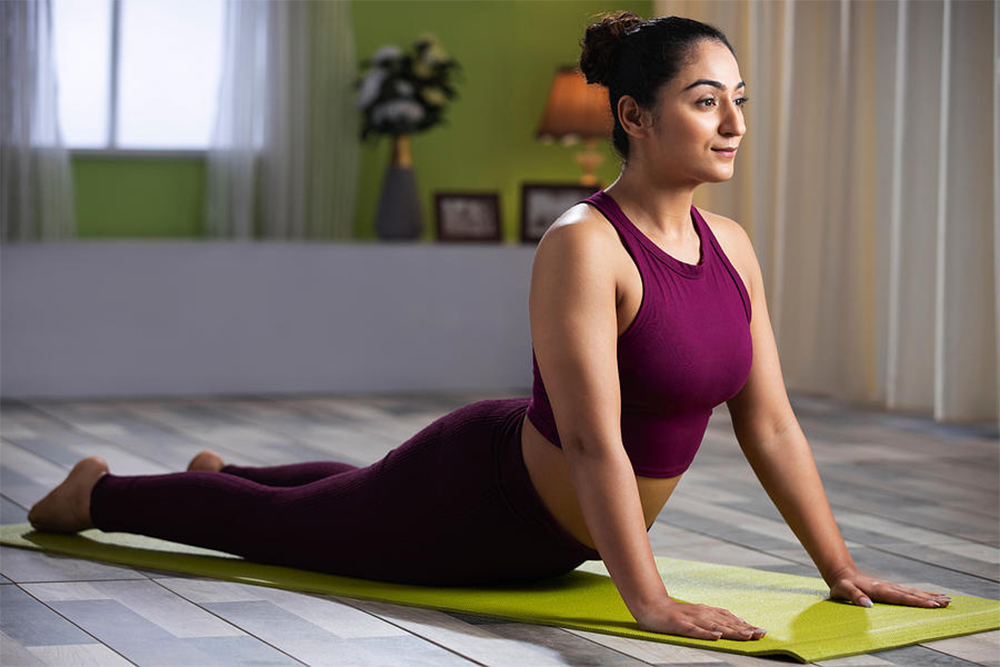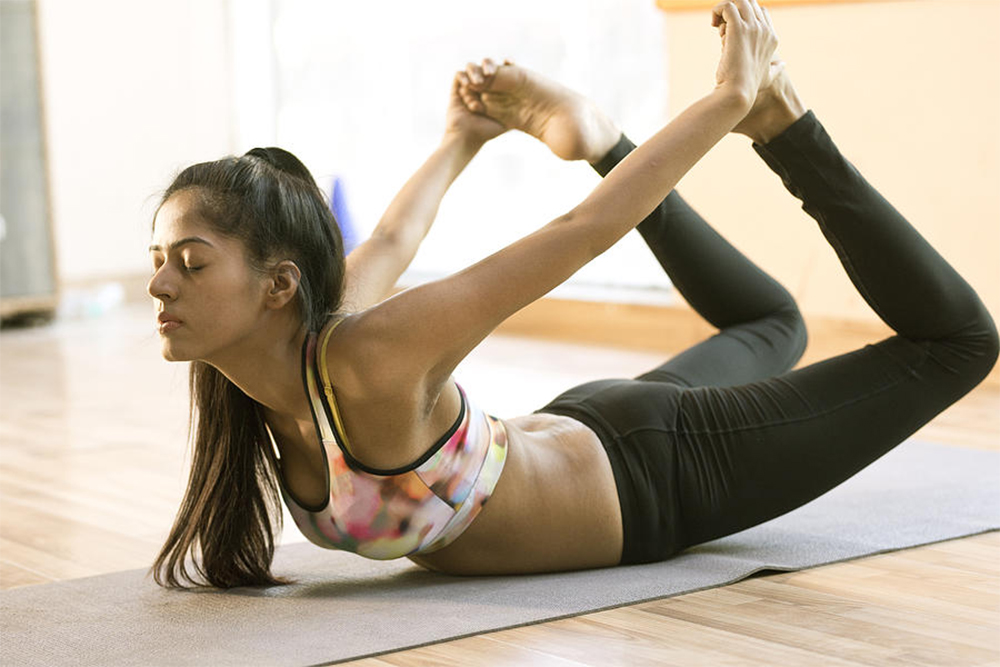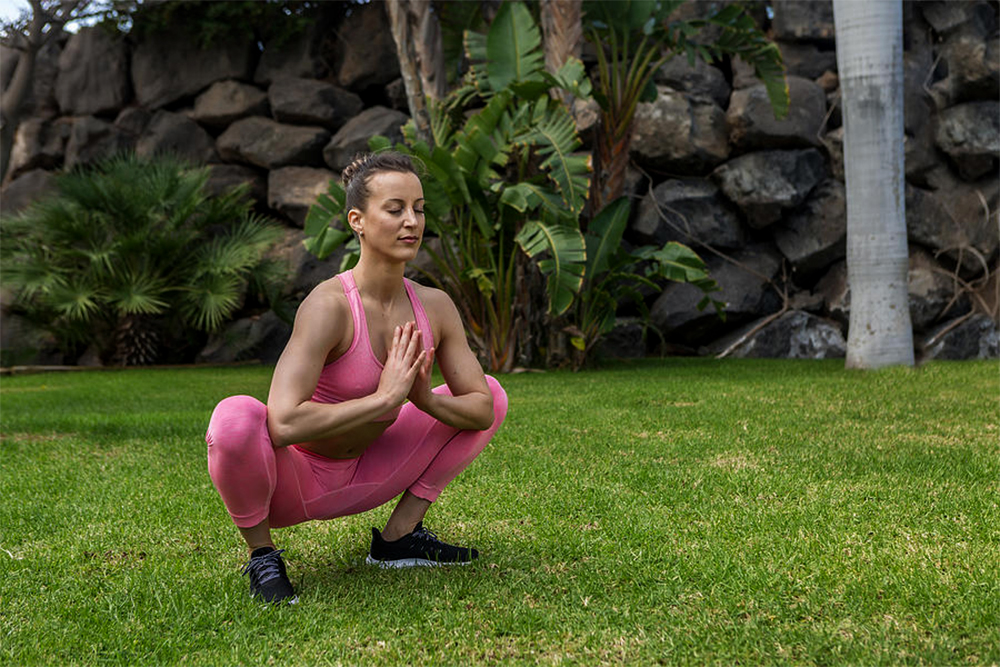According to studies, one in five (20%) women in India suffer from PCOS (polycystic ovary syndrome). Women suffering from PCOS (or PCOD) are more likely to have diabetes, high blood pressure, and other health problems. Yoga for PCOS is a natural way of shedding that extra fat.
What is PCOS
Polycystic Ovarian Syndrome (PCOS) is a type of hormonal disorder in women. It is the most common cause in women presenting with infertility. PCOS is a syndrome, not a disease. This condition is lifelong among women that continues far beyond childbearing years.
Symptoms
- Irregular and delayed menstrual cycles or no periods at all because of lack of ovulation
- Increased facial hair (hirsutism), acne, thinning scalp hair because of excess male hormones
- Multiple ovarian cysts sometimes seen in an ultrasound
Yoga for PCOS- Poses that Help
How yoga benefits symptoms of PCOS
Did you know that prescribed contraceptives for PCOS can cause severe side effects such as nausea, stomach pain, and abdomen pains? On the other hand, yoga has zero side effects.
Are there any specific yoga poses that anyone can easily do at home and help in improving PCOS symptoms.? Yes! Here are 7 most effective yoga poses to treat PCOS.
Bridge Pose or Setu Bandha Sarvangasana

Bridge pose is a reclined backbend and chest-opening yoga pose. It is the most effective yoga pose for regulating thyroid function, which is crucially linked to PCOS.
Steps to Perform
- Lie on your back and bend your knees
- Adjust your feet and arms
- Lift your lower back, mid-back, and upper back off the floor one at a time
- Interlace your hands behind your back and tuck your chin
- Relax your glutes and engage your inner thighs
- Lift your hips higher
- Keep breathing and stay in this pose for 1-2 minutes
- To finish, exhale and slowly release your hands
Cobra Pose or Bhujangasana

The cobra pose is a simple and easy yoga asana. Women of all ages can benefit from this asana. It helps in making body flexible and de-stress your system.
Steps to perform
- Lay straight on your stomach and your legs together.
- Keep your elbows close to your body and place your palms facing down on the floor next to your waist.
- As you inhale, start straightening your arms to lift your chest off the floor and try to recline backwards as much as you can.
- Your navel should be touching the floor
- Hold this position for 15-30 seconds.
- To finish, exhale slowly and return to starting position.
Boat Pose or Naukasana

It is one of the best yoga asanas for PCOS. It works on the abdominal muscles and organs. It is also known to control thyroid function, an important aspect of PCOS. It helps to reduce fat and enriches the function of the ovaries.
Steps to perform
- Lay straight on your back. Place your arms straight along your sides with palms facing down
- Take a deep breath in and as you exhale, start elevating your arms and legs to make a boat-like shape
- Ensure that your eyes, fingers and toes should be in a line.
- Try to stay in the pose for 30 seconds to one minute.
- To finish, exhale and come back to the ground slowly and relax.
Bow Pose (Dhanurasana)

One of the best poses to help people with PCOS alleviate symptoms, Dhanurasan is also stimulates the reproductive organs, relieves menstrual discomfort – cramps, stiffness, and normalizes menstrual cycles.
Steps to perform
- Start lying down on your belly with your arms at your sides
- Fold your knees up and come close to your hips.
- Reach back with your hands to hold your feet or ankles
- While inhaling, lift your chest up off the ground while pulling your legs up
- Hold the pose for 15 seconds
- To finish, exhale, gently bring your chest and legs back to the ground. Release the ankles and relax, face down.
Malasana or Garland Pose

A great pose for women suffering irregularity in mensus, as well as those wanting to bear children as it helps open up the hip and pelvic girdle. Hence, it reduces your symptoms of PCOS.
Steps to perform
- Come to stand with your feet
- Bend your knees and lower your butt toward the floor
- bend the elbows to bring your hands in prayer position (Anjali Mudra)
- Press your upper arms/triceps inside of your knees with spine straight
- Hold this for up to 5 breaths
- Repeat this pose three times to take full advantage
Balasana or Child’s Pose

It is a ‘counter’ asana for many asanas and performed preceding and following Sirsasana as it is a resting pose. It helps the body return to its normal state after being stretched and lengthened in the other different asanas.
Steps to perform
- Sit on your heels on the floor or on a yoga mat
- You can keep your knees together or spread as wide as your mat
- Exhaling, slowly bending forward by lowering your forehead to touch the floor
- Keep your arms alongside your body.
- Alternatively, you can keep your arms towards the front of the yoga mat, palms facing down.
- Gently press your chest on the thighs
- Hold for 45 seconds to 1 minute. Regulate your breath
Surya Namaskar

Surya namaskar is listed under the best PCOS exercise at home. This is especially effective for anyone suffering from PCOS which is a common ailment among today’s women.
Steps to perform
Step-1 Pranamasana (Prayer pose)
Start with standing straight with the feet together. Move your arms in front of your chest and place your palms together in a prayer position
Step-2 Hastauttanasana (Raised arms pose)
Inhaling, lift your arms up and back. Keep your biceps close to your ears with your palms facing front.
Step-3 Hastapadasana (Standing forward bend)
Exhaling, bend forward from the waist keeping the spine erect. As you exhale completely, place your palms on the floor in line with your feet.
Step-4 Ashwa Sanchalanasana (Equestrian pose)
Inhale and push your right leg back. Bring the right knee to the floor and look up. Ensure that the left foot is exactly in between the palms.
Step-5 Dandasana (Stick pose)
Breath in, take the left leg back and bring your whole body in the push-up position and hold for 1-2 seconds.
Step-6 Ashtanga Namaskara (Salute with eight parts or points)
Exhale and bring your knees down to the floor. Both your hands, knees, chin and the chest should touch the floor while raising your posterior a little bit.
Step-7 Bhujangasana (Cobra pose)
Slide forward and raise your upper body upward into the Cobra pose and look up at the ceiling.
Step-8 Adho Mukha Svanasana (Downward facing dog pose)
Breathing out and lift the hips up gently to form an inverted ‘V’ pose. Straighten your elbows and knees. f possible, try and keep the heels on the ground.
Step-9 Ashwa Sanchalanasana (Equestrian pose)
Inhale, bring your right foot forward in between the two hands. Keep your left leg stretched. Press the hips down and look up.
Step-10 Hastapadasana (Standing forward bend)
Breathing out, bring your left foot forward, next to your right foot. Keep the palms on the floor.
Step-11 Hastauttanasana (Raised arms pose)
Breathing in, lift up your upper body, join the palms and raise your hands upwards. Bend backward and stretch your spine.
Step-12 Tadasana (Mountain Pose)
Exhale and stand straight, relaxing your body. Bring the arms in front of your chest in a Namaste.
Continue breathing in and out as you perform this yoga
Takeaway
Women living with PCOS can feel frustrating and anxious about weight, excess body & facial hair, and the ability to become pregnant. Finding ways to manage the symptoms and staying healthy can help you feel better.
Maintaining a healthy lifestyle is important for tackling PCOS, and practicing yoga regularly can help you manage your symptoms and decrease testosterone levels. It can also promote relaxation.
Remember, practicing yoga is only one part of an overall treatment plan for PCOD/PCOS. Healthy diet, cardio exercises, strength training, meditation, and medication are all treatment options your doctor may recommend.
*It is advisable to perform these yoga asanas under a trained yoga teacher.
